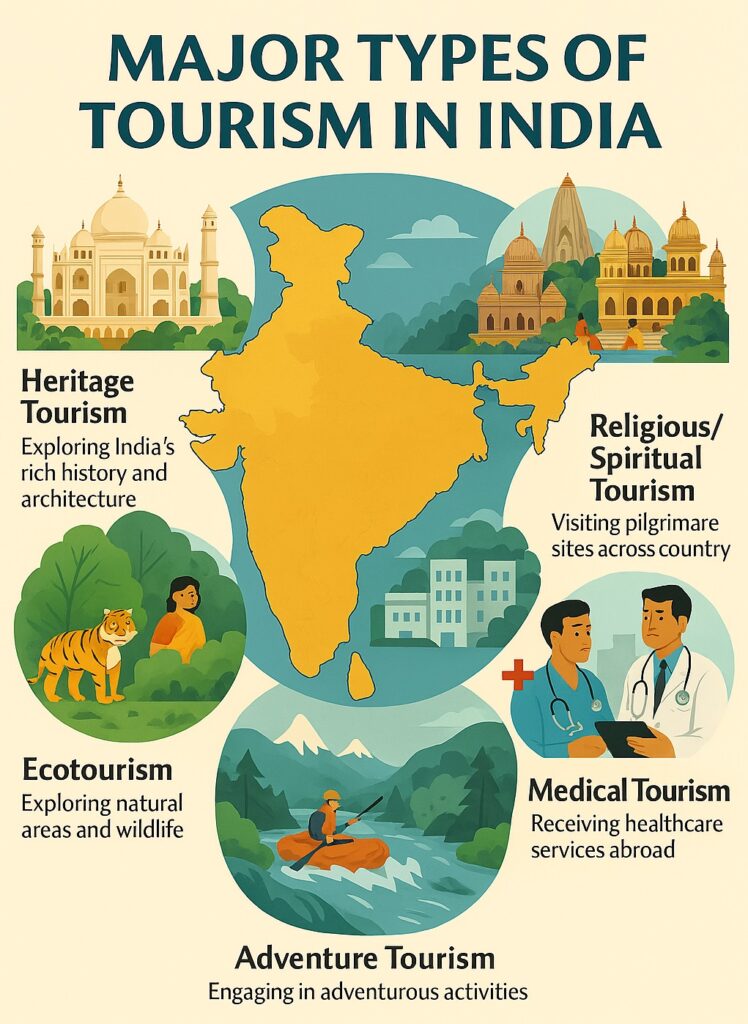Tourism in India is a dynamic and fast-growing sector that significantly contributes to the country’s economy, cultural exchange, and employment. Blessed with diverse geography, rich cultural heritage, historical landmarks, and spiritual traditions, India offers a wide range of tourism experiences—from heritage tourism and adventure travel to spiritual pilgrimages and ecotourism.
Table of Contents
Importance of Tourism in India
- Economic Contribution: Tourism contributes around 9% to India’s GDP and supports millions of jobs directly and indirectly.
- Foreign Exchange Earnings: It is a major source of foreign exchange through international tourists.
- Cultural Exchange: Promotes India’s heritage, traditions, and cultural values globally.
- Development Driver: Boosts infrastructure development, transportation, hospitality, and local entrepreneurship.

Major Types of Tourism in India
- Heritage Tourism:
Visiting historic forts, palaces, and UNESCO World Heritage sites like Taj Mahal, Hampi, and Jaipur. - Religious/Spiritual Tourism:
Destinations such as Varanasi, Rishikesh, Amritsar, Tirupati, and Bodh Gaya attract pilgrims from across the globe. - Medical Tourism:
India is a hub for affordable and quality healthcare, attracting patients from Asia, Africa, and the Middle East. - Adventure Tourism:
Trekking in the Himalayas, river rafting in Rishikesh, and scuba diving in Andaman Islands appeal to thrill-seekers. - Ecotourism:
A responsible form of travel focused on sustainability and nature conservation (explained in detail below).

Ecotourism in India
What is Ecotourism?
Ecotourism is a form of sustainable tourism that aims to conserve the environment, respect local cultures, and promote education and awareness among tourists. It emphasizes low-impact travel to natural areas.
Goals of Ecotourism:
- Conservation of biodiversity
- Empowerment of local communities
- Environmental education for tourists
- Minimizing negative impacts of tourism
Key Ecotourism Destinations in India:
- Kaziranga National Park (Assam)
Famous for the one-horned rhinoceros and rich birdlife. - Sundarbans (West Bengal)
Home to Royal Bengal tigers and world’s largest mangrove forest. - Periyar Wildlife Sanctuary (Kerala)
Promotes nature walks, bamboo rafting, and conservation awareness. - Great Himalayan National Park (Himachal Pradesh)
A UNESCO World Heritage Site rich in alpine flora and fauna. - Silent Valley National Park (Kerala)
A biodiversity hotspot with rare and endangered species. - Spiti Valley (Himachal Pradesh)
Promotes community-based tourism with homestays and eco-guides.
Government Initiatives for Promoting Tourism
- Incredible India Campaign: International branding to attract tourists.
- Dekho Apna Desh: Encourages domestic tourism.
- Swadesh Darshan Scheme: Developing thematic tourist circuits (e.g., Buddhist Circuit, Coastal Circuit).
- PRASAD Scheme: Promoting pilgrimage and spiritual tourism.
- Eco-Tourism Policy Guidelines: Issued by MoEFCC to regulate and encourage sustainable travel.
Challenges in Tourism Development
- Environmental degradation due to unregulated tourism.
- Cultural erosion and commercialization of heritage sites.
- Poor infrastructure in rural and remote tourist destinations.
- Safety concerns in some tourist regions.
- Need for skilled manpower in the tourism and hospitality sector.
Conclusion
Tourism, including ecotourism, holds tremendous potential in India for promoting sustainable development, conserving the environment, and uplifting rural communities. With proper planning, education, and regulation, tourism can be a powerful tool for economic growth, cultural preservation, and ecological balance.
Read: Geography Notes